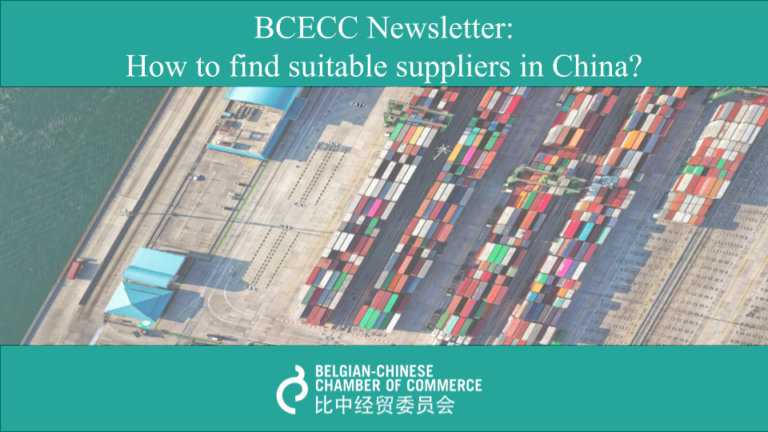Sourcing from China, yes or no?
In the past 4 to 5 years, Belgian companies sourcing from China were faced with geopolitical tensions, a Covid pandemic, freight disruptions and other supply chain issues. As a result, many Belgian companies aim to diversify their supplier base, in order to reduce dependency on China compared to before.
Although many companies claim they plan to relocate part of their sourcing volumes to South-East Asia or even Europe, and terms such as ‘reshoring’ and ‘nearshoring’ have become trendy, China remains an irreplaceable sourcing hub for many Belgian companies. Despite rising cost levels and other adverse factors, thanks to its capacity, scale and infrastructure, China remains relatively cost-efficient. In practice, few other countries offer the same competitiveness as China and often there aren’t many alternatives to sourcing from China.
Developing a supply chain strategy first.
Before you start sourcing, it is important to perform an analysis of your value chain. What is the total cost of goods of your products composed off? What are the key motivations to start looking for suppliers in China? Did you check whether there are any import duties or import restrictions when importing components or (semi-finished) products from outside the EU? Did you perform a benchmarking analysis against alternative suppliers and geographies? What are acceptable order quantities and expected delivery lead times and what kind of flexibility can you accept? Which quality criteria are important for you? Have you taken measures to protect your intellectual properties or company secrets?
How to find suppliers in China?
A good way to start your research is using platforms such as Alibaba.com, Made-in-china.com or Globalsources.com. These platforms list thousands of verified suppliers and give you a certain degree of security when looking for suitable suppliers in China. These platforms even offer additional services, such as communication services, knowledge & CRM tools, payment services, quality inspections and logistics support.
Despite the evident advantages of sourcing through these platforms, there are also a lot of shortcomings. An overarching disadvantage of these platforms is that sourcing from China is often presented as an easy business, which in many cases it obviously is not. In the following paragraphs we give you a few tips & tricks to successfully source in China.
Selection of the best suppliers.
By making use of the above public sources, you can prepare a long list of potential suppliers. Make sure to also do your own research or talk to other companies in your industry. Obviously, you may also ask help from a sourcing consultant. Not only can they more easily search on Chinese search engines, they usually have Chinese staff, and they may also have direct connections to certain Chinese suppliers in your industry.
This long list of potential suppliers should then be screened based on different standardized criteria, such as for example:
- Technical capabilities
- Financial situation
- Risk management policies
- Sustainable business practices
- Availability of certifications and licenses
- Quality assurance standards and quality control protocols
- Sensitivity to disturbances in the supplier’s own supply chain
- Communicative skills
- Your position in the supplier’s priority line
After doing this first analysis, you can make a preselection of 3 to 5 most qualified suppliers and start a more comprehensive due diligence. At that moment it is advisable to pay a visit to these preselected suppliers and do a factory visit. Take someone with you who speaks Chinese, so that you can personally inspect their facilities, ask relevant questions, do random tests, check if your contacts are actually working there or are authorized representatives of the company, if possible talk to third parties (customers, suppliers, competitors, governments, trade associations, media), ask for foreign references, check the official company chop, business license and other company documents (tax certificates, IP registrations, lease agreement/land-use right certificate, financial documents), etc.
Signs of suspicion
While identifying suitable suppliers, don’t hesitate to ask questions. You would be surprised that Chinese suppliers can be quite open and transparent if they are eager to work with you. If they don’t want to share important information with you, that is usually a sign that there is something wrong.
Hereunder we have listed a few typical signs of suspicion. Although some of these individual items may not be a cause for concern, a combination of multiple of these factors may be worrying and be an indication for a possible scam.
Signs of suspicion
- It’s all too good to be true.
- Website is only in English.
- Pushing you all the time – Chinese suppliers love to play on the patience of Westerners.
- No verifiable track-record.
- No company e-mail address.
- Contact person only using an English name.
- Information does not add up – your gut is telling you something is not right.
- No production facilities / no license / no staff.
- Considerably cheaper than market average price.
- Your contact does not work for the company.
- Communication style or contact person is changing.
- They are requesting for facilitation fees or full upfront payment.
In short: when selecting your Chinese suppliers, use common sense. Usually that will bring you far and avoid future problems.
Please contact the Belgian-Chinese Chamber of Commerce (BCECC) in case you need more information.

